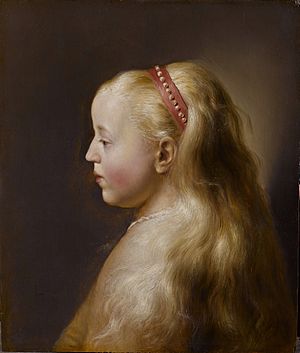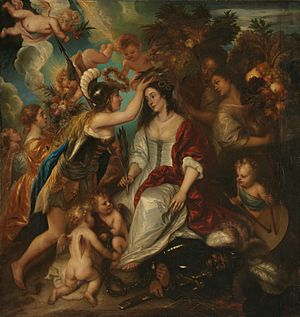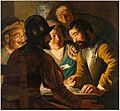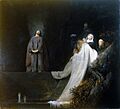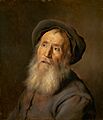Jan Lievens facts for kids
Quick facts for kids
Jan Lievens
|
|
|---|---|
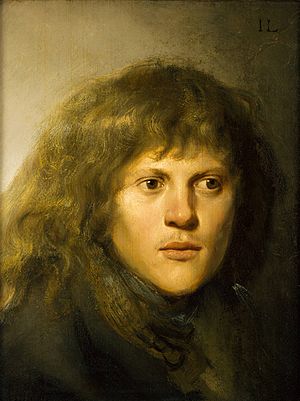
Self portrait
|
|
| Born |
Jan Lievens
24 October 1607 |
| Died | 4 June 1674 (aged 66) Amsterdam, Dutch Republic
|
| Nationality | Dutch |
| Education | Pieter Lastman |
| Known for | Portrait painting |
Jan Lievens (born October 24, 1607 – died June 4, 1674) was a famous Dutch Golden Age painter. He was born in Leiden, Dutch Republic, just like his friend and fellow artist, Rembrandt. They were very close early in their careers. They even trained together with Pieter Lastman in Amsterdam. For about five years until 1631, they shared a studio.
Like Rembrandt, Lievens painted many different things. He created portrait paintings of people and large history paintings that told stories. But unlike Rembrandt, Lievens traveled a lot for his art. He worked in cities like London, Antwerp, The Hague, and Berlin.
Contents
Early Life and Talent
Jan Lievens was the son of Lieven Hendriksze, who was an embroiderer. Jan started learning to paint at a very young age. When he was about 10, he went to Amsterdam to train with the artist Pieter Lastman for two years.
After this training, Jan became an independent artist in Leiden when he was only about 12 years old. He quickly became well-known because of his amazing talent at such a young age. People especially admired his copy of a painting called Democriet & Herakliet by Cornelis van Haarlem. They also loved a portrait he painted of his mother, Machtelt Jans van Noortzant.
His talent caught the eye of important people. Around 1620, Maurice of Nassau, Prince of Orange, bought a large painting from him. It showed a young man reading by the light of a fire. The Prince gave this painting to the English Ambassador, who then gave it to King James I of England. This led to Lievens being invited to the British court in 1631 when he was 24.
Working with Rembrandt
Jan Lievens and Rembrandt van Rijn worked closely together. They shared a studio from about 1626 to 1631. They often competed in a friendly way, and their styles were so similar that it can sometimes be hard to tell their paintings apart from this time.
Lievens was very good at painting large, life-size pictures. His dramatic paintings show that he was influenced by artists known as the Caravaggisti. A writer named Constantijn Huygens thought Lievens was more creative than Rembrandt, but Rembrandt was better at showing feelings. The two artists went their separate ways in 1631. Rembrandt moved to Amsterdam, and Lievens went to England. Even years later, in 1656, Rembrandt still owned paintings by his old friend.
Travels and Later Life
While in England, Lievens painted a portrait for Thomas Howard, 21st Earl of Arundel. He was also influenced by the work of another famous painter, Anthony van Dyck.
After his time in England, Lievens settled in Antwerp. There, he married Suzanna Colyn de Nole in 1638. She was the daughter of a sculptor. During this period, he received many requests for paintings from kings, mayors, and city halls. For example, he painted a large artwork for the Leiden city hall.
In 1661, he created a special painting for the mayor's office in the Amsterdam city hall. This building is now the Royal Palace of Amsterdam. The painting showed Brinno being lifted onto a shield by the Cananefates.
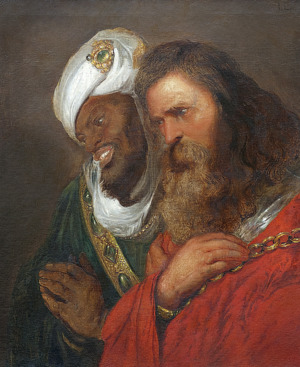
Lievens also worked as a court painter in The Hague and Berlin. He returned to Amsterdam in 1655. After his first wife passed away, he married the sister of another artist, Jan de Bray, in 1648.
Later in his life, especially after 1672 (a difficult year in Dutch history known as the "Rampjaar"), Lievens faced money problems. When he died, his family decided not to claim any inheritance because of his debts.
Rediscovered Art
In 2022, a drawing by Lievens that had been missing for a long time was found again. It was last seen at an auction in 1888. This rediscovered drawing was sold for a lot of money at an art fair called TEFAF Maastricht.
Public Collections
You can find Jan Lievens's artwork in many museums around the world, including:
- Agnes Etherington Art Centre
- Amsterdam Museum
- Mauritshuis, The Hague
- Museo Thyssen-Bornemisza, Madrid
- Museum de Fundatie, Zwolle
- Rijksmuseum Amsterdam
- The Walters Art Museum, Maryland
- Utah Museum of Fine Arts
- A portrait of Virgil by Lievens is at the Snite Museum of Art at Notre Dame University in South Bend, Indiana.
Images for kids
-
The Feast of Esther, North Carolina Museum of Art.
See also
 In Spanish: Jan Lievens para niños
In Spanish: Jan Lievens para niños


